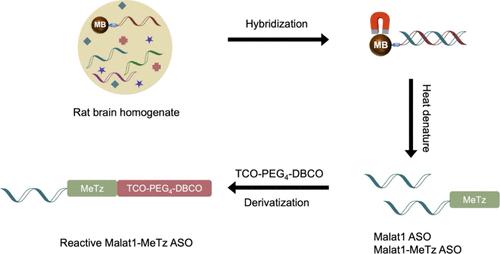Quantitative Determination of Click-Reactive Antisense Oligonucleotide and Its Reactivity in Rat Brains by Hybridization LC-MS/MS to Support Pretargeted PET Imaging
IF 6.7
1区 化学
Q1 CHEMISTRY, ANALYTICAL
引用次数: 0
Abstract
Antisense oligonucleotide (ASO) therapeutics are rapidly increasing in prevalence for the treatment of neurodegenerative diseases. A novel pretargeted positron emission tomography (PET) imaging methodology based on in vivo click chemistry was developed recently to assess ASO biodistribution in the brain. To validate the performance of the method, a sensitive, accurate, and reliable method to quantitatively determine the reactivity and distribution of click-reactive ASO in the brain is required. A major challenge is that the click-reactive ASO may undergo oxidation or rearrangement in vivo and lose reactivity to the TCO on the radiotracer. With their small mass differences, it is difficult to differentiate these unreactive degradants from the intact reactive ASO by LC-MS/MS. Here, we developed a novel postextraction analyte derivatization methodology utilizing conjugation of the click-reactive ASO, Malat1 ASO with a 1,2,4,5-methyltetrazine (MeTz) modification (Malat1 ASO-MeTz), with a TCO ligand (TCO-PEG4-DBCO) to differentiate the reactive and unreactive ASOs. The intact and reactive form of Malat1 ASO-MeTz was determined by LC-MS/MS analysis of the conjugation reaction product. A hybridization LC-MS/MS method that simultaneously quantifies Malat1 ASO-MeTz and Malat1 ASO over the range of 1.00–1000 ng/mL was also developed to determine the ASO distribution in rat brains. The methods were successfully applied to a pretargeted PET imaging study in rats. This is the first report that a postextraction analyte derivatization methodology was successfully developed for determining the reactive form and reactivity of click-reactive ASOs. The developed bioanalytical methodology will also significantly facilitate the evaluation of other radiotracers for pretargeted PET imaging.

用LC-MS/MS杂交技术定量测定大鼠脑中点击反应性反义寡核苷酸及其反应性,以支持预靶向PET成像
反义寡核苷酸(ASO)疗法在神经退行性疾病的治疗中迅速增加。近年来,一种新的基于活体点击化学的预靶向正电子发射断层扫描(PET)成像方法被开发出来,用于评估ASO在大脑中的生物分布。为了验证该方法的性能,需要一种灵敏、准确、可靠的方法来定量确定大脑中点击反应性ASO的反应性和分布。一个主要的挑战是,点击反应性ASO可能在体内被氧化或重排,并失去对放射性示踪剂上的TCO的反应性。由于它们的质量差很小,很难通过LC-MS/MS将这些未反应的降解物与完整的反应性ASO区分开来。在这里,我们开发了一种新的萃取后分析物衍生化方法,利用键合反应性ASO, Malat1 ASO与1,2,4,5-甲基四嗪(MeTz)修饰(Malat1 ASO-MeTz)结合TCO配体(TCO- peg4 - dbco)来区分反应性和非反应性ASO。结合产物的LC-MS/MS分析确定了Malat1 ASO-MeTz的完整反应形态。建立了在1.00 ~ 1000 ng/mL范围内同时定量测定Malat1 ASO- metz和Malat1 ASO的LC-MS/MS杂交方法,测定ASO在大鼠脑内的分布。该方法已成功应用于大鼠PET预靶向成像研究。这是首次成功开发萃取后分析物衍生化方法,用于确定点击反应性ASOs的反应形式和反应性。开发的生物分析方法也将大大促进其他放射性示踪剂的预靶向PET成像的评估。
本文章由计算机程序翻译,如有差异,请以英文原文为准。
求助全文
约1分钟内获得全文
求助全文
来源期刊

Analytical Chemistry
化学-分析化学
CiteScore
12.10
自引率
12.20%
发文量
1949
审稿时长
1.4 months
期刊介绍:
Analytical Chemistry, a peer-reviewed research journal, focuses on disseminating new and original knowledge across all branches of analytical chemistry. Fundamental articles may explore general principles of chemical measurement science and need not directly address existing or potential analytical methodology. They can be entirely theoretical or report experimental results. Contributions may cover various phases of analytical operations, including sampling, bioanalysis, electrochemistry, mass spectrometry, microscale and nanoscale systems, environmental analysis, separations, spectroscopy, chemical reactions and selectivity, instrumentation, imaging, surface analysis, and data processing. Papers discussing known analytical methods should present a significant, original application of the method, a notable improvement, or results on an important analyte.
 求助内容:
求助内容: 应助结果提醒方式:
应助结果提醒方式:


